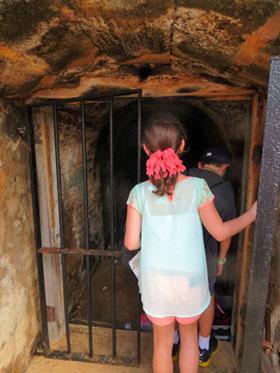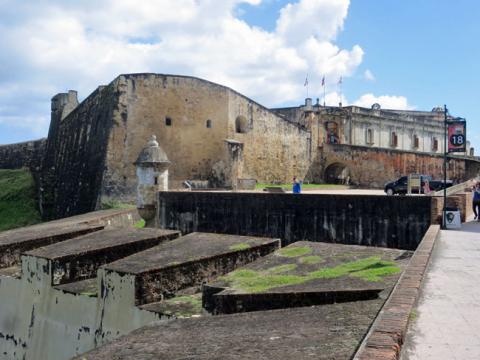If you look at the Facebook page for San Juan National Historic Site in San Juan, Puerto Rico, you'll see that the cover photo shows a man driving a dog sled through heavy snow. That's no mistake; it's only one sign that the historic site will be an entertaining place to visit.
"Columbus didn't discover the New World. The Indians found a lost bunch of Spaniards," Ranger Emmanuel Rodriguez said in his introductory tour.
Though there's no written account of Christopher Columbus ever landing in Puerto Rico, he must have seen enough to report to his Spanish benefactors that Puerto Rico was a place worth exploring and colonizing.
The San Juan National Historic Site comprises the oldest European construction in the National Park Service. Puerto Rico is located in a strategic spot in the Western Hemisphere. During European exploration and colonization, trade winds easily blew sailing ships here from Europe. The island was the first major spot for ships to resupply with food, clean water, rest, and probably women, though the ranger didn't mention that last one.
All the major European countries, hellbent on colonizing the rest of the world, vied for Puerto Rico, but Spain got here first and fought for 400 years to hold it. At the time, Puerto Rico, which means Rich Port, was the gateway to the New World. From the island, they could explore the Western Hemisphere where they found gold, silver, spices, and jewels by the ton.
Ponce de Leon founded the Spanish colony in 1508. To help them hold this precious land, the Spaniards built Castillo San Felipe del Morro, starting in 1539 at the headlands of the island. It was meant to protect the entrance to the Caribbean and to control access to South American gold and wealth. Later, Fort El Canuelo, a half mile across the mouth of the bay, allowed for crossfire if an enemy tried to enter the harbor. Though Castillo can mean "castle," these forts were places of war.
Other European countries tried to wrest Puerto Rico from Spain. Sir Francis Drake first attacked in 1595. The second British attach was successful, but they "died of bad hygiene," -dysentery- and left. The Spaniards understood the importance of clean water and didn't allow animals in the fort. So all construction work was done by hard hand labor.
The Dutch came next, in 1625, and attacked by land. They managed to burn San Juan, causing total devastation, but they too left eventually. The Spanish built a wall around the city and started Castillo San Cristobal, on the east side of Old San Juan, to ward off another land attack. One more major attack by Great Britain occurred in 1797, but the Spanish held on.
"If England had won the war, I'd be speaking like Benny Hill instead of like Ricky Ricardo," Ranger Jose L. Gonzalez said while leading the San Cristobal tunnel tour.
Ranger Gonzalez walked us up and down the secret passages and stairs that we might have missed on our own exploration. The final tunnel can only be accessed on a ranger tour, limited to 15 people.
The ranger opened the rusty low gates with a large key. We each took a flashlight and silently entered the tunnel. Then he closed the gate so that another visitor couldn't wander in randomly.

Entering the tunnel
We walked through the narrow, dark tunnel in a single file. At the end, we reached two slits in the walls where the Spaniards looked out for enemy ships. The tunnel was a potential minefield and a lookout, considered a masterpiece of 18th century engineering. The openings, called loopholes, provided the only air for the soldiers.
"Imagine the soldier with a lit torch in one hand and explosives in the other. They had better keep their two hands apart," Ranger Gonzalez said. This was not a great assignment for the soldiers, and was probably considered a punishment.
Castillo San Cristobal was the setting for a TV movie, The Wizard of Waverly Place with Selena Gomez, a popular teen celebrity. Since we had a couple of teenage girls on the tour, Ranger Gonzalez pointed out every single place where Selena Gomez stood; he had really studied the movie. The girls were so excited to hear his anecdotes. I suppose that's one way you get children interested in national parks.
A mile-long walk on the city street takes you to El Morro, the older and smaller of the two forts, with six levels. You can go up and down circular steps and ramps to towers and plazas. The magnificent view across to the mouth of the bay makes you appreciate the damage that can be done by crossfire. It's also the place to have your picture taken, with the Atlantic Ocean as the background.
Each fort has a chapel. One of the goals of Spanish colonization was to spread Catholicism. In Cristobal, Saint Barbara, the patron saint of people in danger of fire or explosion, was meant to protect soldiers working with dangerous cannons. A Virgin Mary stands in the El Morro fort. In front of each statue is a donation box, encouraging visitors to support the national park. It's a weird place to put a donation box but maybe they get more money this way.
How did the forts go from Spanish control to national park? The United States declared war against Spain in 1898 to support Cuban independence. The Navy bombarded San Juan to prevent Spanish troops and supplies from reaching Cuba. The forts were no match for 19th century firepower. Spain agreed to Cuban independence and ceded its remaining colonies, Puerto Rico, Guam, and the Philippines to the United States. Because of the strategic location of the port, the United States didn't want to give up Puerto Rico. Also, as the ranger pointed out, "Temperance was looming. Americans needed a place to drink."
The Spanish American War established the United States as a superpower. This is the war where Teddy Roosevelt charged up San Juan Hill, but in Cuba, not in Puerto Rico. The forts were used in both World Wars.
On an outside wall at the El Morro site there's a plaque, entitled "Copeland's Corner," honoring a woman who contributed to golfing in San Juan. When the military had control of the forts, they brought golf to Puerto Rico and built a nine-hole course around the walls of the fort. The golf course is long gone from the historic site and golf can be played at the many resorts around the island. The forts were incorporated into the National Park System in 1949 but the Army didn't move out until 1961.
Visiting San Juan National Historic Site
Orientation tours, lasting 20 minutes, are given every hour on the hour at each fort; the content is the same. If you can go on a weekend, you can sign up for other ranger-led tours. Based on the tour you want to sign up for, start at that fort. A flat, one-mile walk will take you to the second fort. The Park Service provides a free trolley between the two forts. Give yourself a full day to visit both forts; they're worth the time.




Comments
Yes, every park has a backlog because it is going far beyond being just a natural landscape. While I may not disagree in every case, I was just pointing out the irony of you not liking parks that aren't natural landscapes while promoting non-natural landscape activities.
Rambler. I dont know that park budgets are adequate. Probably not. But it isnt so much park priorities and entitlements that need to be looked at as national priorities and entitlements.
EC I am not quite sure what 'non-natural landscape activities' I promoted. If you are referring to the non-natural infrastructure required to operate a park that gets 2 million visitors per year, then yes. I am promoting non-natural restrooms, campgrounds, and interpretive exhibits. Simply designating a park and then turning the public lose in it without providing resources to maintain it is not responsible stewardship in my opinion.
Ranbler. You really dont get the irony? You want to promote "natural landscapes" by building parking lots, gift shops, restaurants, hotels but a historical site isnt worthy?
EC- I did not promote a single thing you mentioned. I mentioned bathrooms, campgrounds, and interpretive exhibits. Three things that I feel are necessary for visitors to enjoy themselves in a large natural park, that also provide a measure of protection. Gift shops, hotels, restaurants are all not necessary. I am all for banning cars from Yosemite Valley and making people get on a bike in El Portal. With that said I get your point, and since the point you made is certainly the model in the natural parks I am advocating for, it is a valid point to bring up.
Sorry, Rambler. Whether national park, city museum or ferry terminal - I'm a sucker for a good gift shop.
But, Rick, do those gift shops have to be INSIDE the park?
Usually just an alcove off of the visitor center. Go in, get trail maps, visit the porcelain convenience, and pick up a new water bottle sort of thing. I don't see it a big deal.
Frankly, that was the least of my problems with Rambler's comments. I live in and my wife works in a national historical park. We have natural landscapes and also have important archeological and cultural resources. I think the park service is good umbrella for both, and figure my opinion is as worthy as Rambler's.